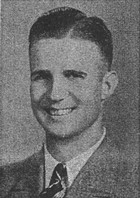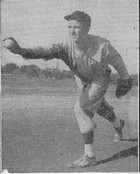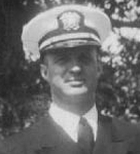Norman Smith
| Date and Place of Birth: | August 22, 1916 Carnegie, GA |
| Date and Place of Death: | August 9, 1942 near Savo Island, Pacific Ocean |
| Baseball Experience: | Minor League |
| Position: | Pitcher |
| Rank: | Ensign |
| Military Unit: | US Navy |
| Area Served: | Pacific Theater of Operations |
Norman Smith was an outstanding college pitcher who was working his way up the minor league system when military service beckoned in January 1942. Less then nine months later the Georgian right-hander was dead.
Norman K. Smith, the son of Jim and Lidie Smith, grew up in Edison, Georgia, where he attended
Edison High
School and first demonstrated his skill as a pitcher. Following
graduation in 1934, he attended Norman Park Junior College and helped
guide the varsity team to the Georgia Junior College league
championships in 1934 and 1935. Smith was 6-1 and 7-2 respectively, with
two one-hitters in the latter year.' He transferred to Mercer
University in the fall of 1935 as a pre-law student. Smith suffered a
broken right arm that Christmas but was fully fit to try out for the
baseball team in the spring of 1936. In his first exhibition game for
the Mercer Ramblers, against former Yankees pitcher Cy Moore and the
Elberton Athletic Club, Smith hurled an impressive two-hitter with 16
strikeouts in the 5-0 win.
Smith was a natural athlete and when he tried his hand at cross-country
running while at Mercer - something he had not done before - he was so
impressive he was made captain of the team. In addition to pitching for
Mercer he hurled during the summer months with East Griffin of the
Middle Georgia Textile League, and in late 1936, he signed with the
Macon Peaches of the Class B South Atlantic League. After 12 unmemorable
appearances for the Peaches at the start of the 1937 season, he was
assigned to the Cordele Reds of the Class D Georgia-Florida League,
where he was 9-1 with an earned run average of 3.00. Back with Macon in
1938, Smith was 3-6 in 17 outings and returned to Cordele where he was
2-8.
He joined the Dayton Wings of the Class C Middle-Atlantic League in
1939, and was 11-10, with a team-leading 121 strikeouts. In 1940, he was
with the Americus Pioneers of the Class D Georgia-Florida League and was
8-8 in 23 games. Back with the Pioneers for 1941, Smith enjoyed his best
professional season as the backbone of the team's pitching staff. He had
a 14-10 won-loss record, a 3.25 ERA and 151 strikeouts in 202 innings.
He joined the Nashville Vols of the Class Al Southern Association at the
end of the year and was 0-2 in four appearances.
After six years of playing professional baseball during the summer and
teaching school in the off-season,
Smith entered military service on January 22, 1942. He served as
an ensign with the Navy aboard the heavy cruiser USS Quincy (CA-39). As
the flagship of Rear Admiral Norman R. Scott, the Quincy arrived in the
South Pacific in July 1942, providing close fire support for the Marines
during the landing at Guadalcanal.
On August 9, 1942, the Quincy, as part of an Allied naval force, was on
patrol between Florida Island and Savo Island. Unknown to them, a
Japanese force of seven cruisers and one destroyer was heading straight
for them and made a surprise attack. Known as the Battle of Savo Island,
the Quincy was caught unprepared for action, hit heavily and set afire.
As she changed direction two torpedoes hit her, and further incoming
shells killed or wounded almost all of her bridge crew, including the
captain. At 2:38 A.M., less than 30 minutes after the attack began, the
Quincy sank, bow first. Ensign Smith was among the 370 that died on the
Quincy, with a further 167 wounded. The American cruisers USS Vincennes
and USS Astoria, and the Australian cruiser HMAS Canberra were also sunk
that day.
Norman Smith's body was never recovered, but he is remembered at the
Manila American Cemetery at Fort Bonifacio in the Philippines. He was
survived by his mother, four brothers (J.T., Marvin, Russell and Agnew)
and two sisters (Mrs. Francis Bugg and Mrs. George Chambers).
On January 14, 1947, a memorial plaque was unveiled at Mercer University in honor of the 44 Mercer students who lost their lives in World War II. In 1961, a plaque, requested by Norman's brother, Agnew, was placed in Mars Hill Cemetery in Edison, Georgia.
|
Year |
Team |
League |
Class |
G |
IP |
ER |
BB |
SO |
W |
L |
ERA |
| 1936 | Macon | South Atlantic | B | - | - | - | - | - | - | - | - |
| 1937 | Macon | South Atlantic | B | 12 | 28 | - | 15 | 20 | 0 | 4 | - |
| 1937 | Cordele | Georgia-Florida | D | - | 90 | 30 | 38 | 76 | 9 | 1 | - |
| 1938 | Macon | South Atlantic | B | 17 | 77 | 26 | 34 | 48 | 3 | 6 | 3.04 |
| 1938 | Cordele | Georgia-Florida | D | - | 76 | 28 | 39 | 42 | 2 | 8 | 3.32 |
| 1939 | Dayton | Mid-Atlantic | C | 23 | 172 | 66 | 70 | 121 | 11 | 10 | 3.34 |
| 1940 | Americus | Georgia-Florida | D | 23 | 146 | 61 | 55 | 85 | 8 | 8 | 3.76 |
| 1941 | Americus | Georgia-Florida | D | 38 | 202 | 73 | 79 | 151 | 14 | 10 | 3.25 |
| 1941 | Nashville | Southern Assoc | A1 | 4 | 9 | 15 | 8 | 1 | 0 | 2 | 15.00 |
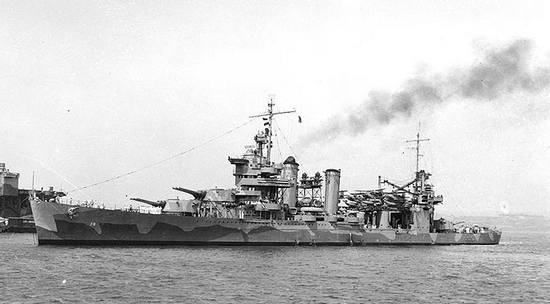
The USS Quincy. Sunk during the Battle of Savo Island on August 9, 1942
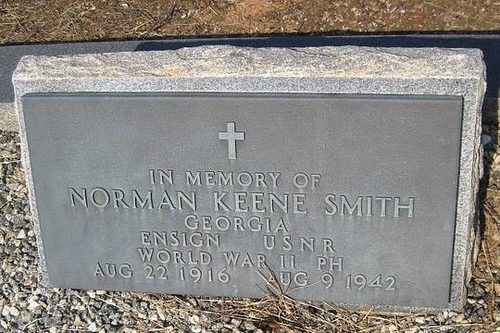
Ensign Smith's marker at Mars Hill Cemetery in Edison, Georgia
Thanks to Laura Botts, Head of Special Collections at Mercer University Jack Tarver Library and Shawn Hennessy for help with this biography.
Date Added: March 7, 2012 Updated June 10, 2014
Baseball's Greatest Sacrifice is associated with Baseball Almanac
Baseball's Greatest Sacrifice is proud to be sponsored by

